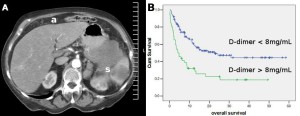D-dimer levels are firmly established as a method of screening patients for venous thromboembolism (VTE). Their sensitivity of over 95% is such that normal levels in most cases can exclude a deep vein thrombosis or pulmonary embolism. However, their specificity is only about 50%. D-dimer levels rise in the elderly, during pregnancy, with immobility and after surgical operations. Similarly, inflammatory states like rheumatoid arthritis, lupus and sickle cell disease are associated with elevated levels. Improving the specificity of D-dimer and evaluating its relationship with malignancy are ongoing areas of research. Cancer associated thrombosis (CAT) is discussed.
PETER ROSE Cancer associated venous thrombo-embolic disease, has a different pathogenesis, requires different management and has poor clinical outcomes compared to non-cancer VTE. D-dimer assays are used in screening suspected VTE patients in conjunction with a two-level Well’s score. This is a recommendation from NICE (2013). However, only 9% of CAT patients are negative for both of these tests making screening for VTE unhelpful in patients with cancer. Since D-dimer levels are raised in cancer patients this is not a useful test in VTE screening. However, very high D-dimer levels may help identify patients with VTE who require cancer screening.
Approximately 5% of patients have cancer diagnosed within 6 months of presentation with a VTE. Most have metastatic disease with overt clinical signs. The higher the D-dimer level at presentation with VTE the greater is the likelihood of an underlying malignancy. A D-dimer level of 8,000 FEU (fibrinogen equivalent units) (16 times above upper limit) in a patient over 60 would equate to a 1 in 2 risk of cancer. D-dimer levels also correlate with poor clinical outcomes in cancer patients with proven VTE and in those without VTE. In summary, D-dimer levels in cancer patients reflect the extent of thrombus formation as well as the extent of the underlying malignancy.
(A) Undiagnosed metastatic disease (ascites a, solid tumour s) in a patient presenting with DVT and a very high D-dimer 10,000 FEU. (B) High D-dimer levels in cancer patients are associated with poor outcomes.
